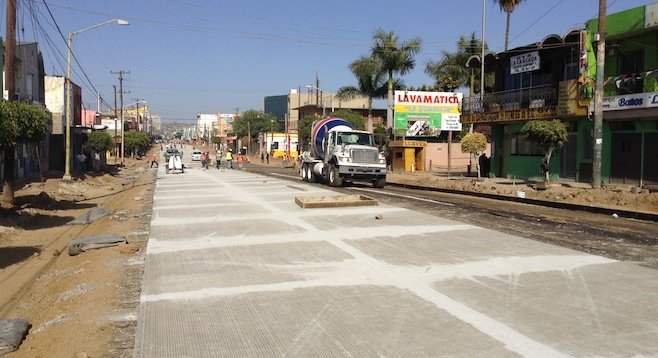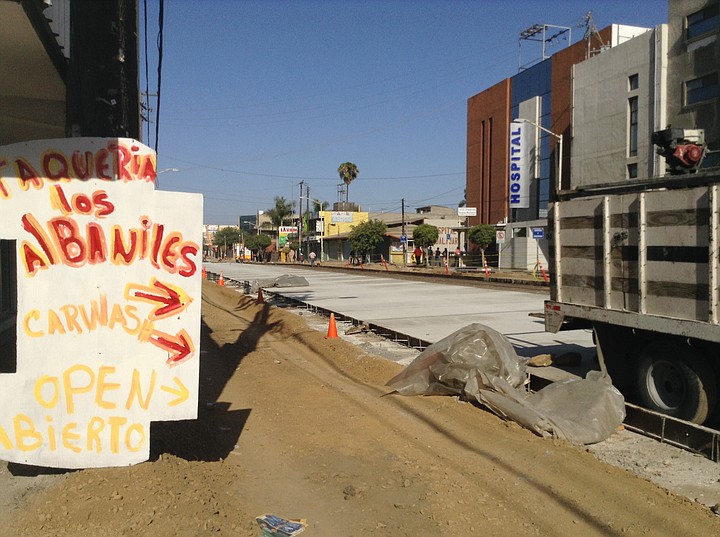 Facebook
Facebook
 X
X
 Instagram
Instagram
 TikTok
TikTok
 Youtube
Youtube

At 5 p.m., a homeless man in a wheelchair tries to cross Second Street but has trouble with the rubble; a transsexual hooker walks by wearing a short dress, stumbling around on her high heels.

Benito Juárez de Tijuana, or Calle Segunda, looks like a war zone heavily policed since the last week of February. Five blocks — from Miguel F. Martínez to Arias Bernal — have been completely destroyed, affecting residents and small businesses. There's almost no public access: sidewalks have been removed, leaving trenches and treacherous paths. Zeta newspaper reports of millions of pesos lost and two businesses closed since they started working on the street.
“Day 8 without water in my apartment. Thank you, Tijuana,” Diana Merchant, a resident on the corner of Second and G sarcastically complains about the water situation. “They shut the water at around 9 a.m. and reactivate it late in the afternoon on any given day. It happens without any warning; they even left us without water for a whole weekend. Apparently, they broke a pipe and didn't bother to fix it until Monday afternoon.”
Without notice, the government started the reconstruction of one of Tijuana’s main streets. New electrical wiring, water pipes, and sewage system are being installed under a new road made out of concrete. You can smell the open sewers from a distance. The work has not been consistent: many times the job is left halfway done and not returned to for days.
The city folk are skeptic and believe that they are wasting time so contractors can fill their pockets. They consider the construction necessary but the execution of it very poor. City officials state that the construction of the first phase will be finished by the end of July. The second phase will take till the beginning of 2015, covering the rest of Calle Segunda from Arias Bernal to Cinco Esquinas.
As of now, the concrete work has been completed up to G street, wide enough for three car lanes, leaving ample space on either side. The space will not be filled with concrete until they finish with the sewage and electrical conduit. The new street is almost a foot higher than it was before; if a sidewalk is to be built, businesses will have to raise their doors.
For a city government that professes to have an eye to the future, there has not been much talk about bike lanes. There is a huge biking community in Tijuana that is in constant danger of getting hit by cars. The remaining space on either side of the street most likely will become spots for parking meters, just like before.
“More bikes, less smog” is the slogan on a best-selling Mexican T-shirt, a message ignored by city officials but that the youth of the city embrace.


At 5 p.m., a homeless man in a wheelchair tries to cross Second Street but has trouble with the rubble; a transsexual hooker walks by wearing a short dress, stumbling around on her high heels.

Benito Juárez de Tijuana, or Calle Segunda, looks like a war zone heavily policed since the last week of February. Five blocks — from Miguel F. Martínez to Arias Bernal — have been completely destroyed, affecting residents and small businesses. There's almost no public access: sidewalks have been removed, leaving trenches and treacherous paths. Zeta newspaper reports of millions of pesos lost and two businesses closed since they started working on the street.
“Day 8 without water in my apartment. Thank you, Tijuana,” Diana Merchant, a resident on the corner of Second and G sarcastically complains about the water situation. “They shut the water at around 9 a.m. and reactivate it late in the afternoon on any given day. It happens without any warning; they even left us without water for a whole weekend. Apparently, they broke a pipe and didn't bother to fix it until Monday afternoon.”
Without notice, the government started the reconstruction of one of Tijuana’s main streets. New electrical wiring, water pipes, and sewage system are being installed under a new road made out of concrete. You can smell the open sewers from a distance. The work has not been consistent: many times the job is left halfway done and not returned to for days.
The city folk are skeptic and believe that they are wasting time so contractors can fill their pockets. They consider the construction necessary but the execution of it very poor. City officials state that the construction of the first phase will be finished by the end of July. The second phase will take till the beginning of 2015, covering the rest of Calle Segunda from Arias Bernal to Cinco Esquinas.
As of now, the concrete work has been completed up to G street, wide enough for three car lanes, leaving ample space on either side. The space will not be filled with concrete until they finish with the sewage and electrical conduit. The new street is almost a foot higher than it was before; if a sidewalk is to be built, businesses will have to raise their doors.
For a city government that professes to have an eye to the future, there has not been much talk about bike lanes. There is a huge biking community in Tijuana that is in constant danger of getting hit by cars. The remaining space on either side of the street most likely will become spots for parking meters, just like before.
“More bikes, less smog” is the slogan on a best-selling Mexican T-shirt, a message ignored by city officials but that the youth of the city embrace.